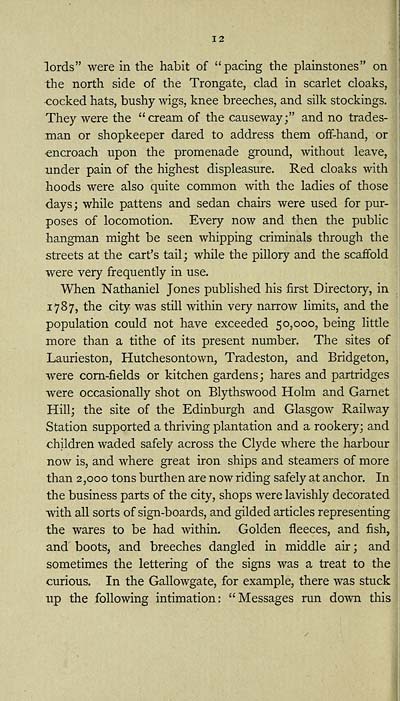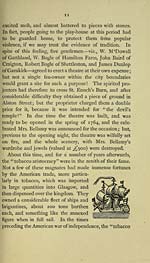Towns > Glasgow > 1787 - Reprint of Jones's directory; or, Useful pocket companion for the year 1787
(20)
Download files
Complete book:
Individual page:
Thumbnail gallery: Grid view | List view

12
lords" were in the habit of "pacing the plainstones" on
the north side of the Trongate, clad in scarlet cloaks,
■cocked hats, bushy wigs, knee breeches, and silk stockings.
They were the "cream of the causeway;" and no trades-
man or shopkeeper dared to address them off-hand, or
■encroach upon the promenade ground, without leave,
under pain of the highest displeasure. Red cloaks with
hoods were also quite common with the ladies of those
days ; while pattens and sedan chairs were used for pur-
poses of locomotion. Every now and then the public
hangman might be seen whipping criminals through the
streets at the cart's tail; while the pillory and the scaffold
were very frequently in use.
When Nathaniel Jones pubHshed his first Directory, in
1787, the city was still within very narrow limits, and the
population could not have exceeded 50,000, being little
more than a tithe of its present number. The sites of
Laurieston, Hutchesontown, Tradeston, and Bridgeton,
were corn-fields or kitchen gardens; hares and partridges
were occasionally shot on Blythswood Holm and Garnet
Hill; the site of the Edinburgh and Glasgow Railway
Station supported a thriving plantation and a rookery; and
children waded safely across the Clyde where the harbour
now is, and where great iron ships and steamers of more
than 2,000 tons burthen are now riding safely at anchor. In
the business parts of the city, shops were lavishly decorated
with all sorts of sign-boards, and gilded articles representing
the wares to be had within. Golden fleeces, and fish,
and boots, and breeches dangled in middle air ; and
sometimes the lettering of the signs was a treat to the
curious. In the Gallowgate, for example, there was stuck
up the following intimation: "Messages run down this
lords" were in the habit of "pacing the plainstones" on
the north side of the Trongate, clad in scarlet cloaks,
■cocked hats, bushy wigs, knee breeches, and silk stockings.
They were the "cream of the causeway;" and no trades-
man or shopkeeper dared to address them off-hand, or
■encroach upon the promenade ground, without leave,
under pain of the highest displeasure. Red cloaks with
hoods were also quite common with the ladies of those
days ; while pattens and sedan chairs were used for pur-
poses of locomotion. Every now and then the public
hangman might be seen whipping criminals through the
streets at the cart's tail; while the pillory and the scaffold
were very frequently in use.
When Nathaniel Jones pubHshed his first Directory, in
1787, the city was still within very narrow limits, and the
population could not have exceeded 50,000, being little
more than a tithe of its present number. The sites of
Laurieston, Hutchesontown, Tradeston, and Bridgeton,
were corn-fields or kitchen gardens; hares and partridges
were occasionally shot on Blythswood Holm and Garnet
Hill; the site of the Edinburgh and Glasgow Railway
Station supported a thriving plantation and a rookery; and
children waded safely across the Clyde where the harbour
now is, and where great iron ships and steamers of more
than 2,000 tons burthen are now riding safely at anchor. In
the business parts of the city, shops were lavishly decorated
with all sorts of sign-boards, and gilded articles representing
the wares to be had within. Golden fleeces, and fish,
and boots, and breeches dangled in middle air ; and
sometimes the lettering of the signs was a treat to the
curious. In the Gallowgate, for example, there was stuck
up the following intimation: "Messages run down this
Set display mode to: Large image | Transcription
Images and transcriptions on this page, including medium image downloads, may be used under the Creative Commons Attribution 4.0 International Licence unless otherwise stated. ![]()
| Scottish Post Office Directories > Towns > Glasgow > Reprint of Jones's directory; or, Useful pocket companion for the year 1787 > (20) |
|---|
| Permanent URL | https://digital.nls.uk/85272039 |
|---|
| Description | Directories of individual Scottish towns and their suburbs. |
|---|
| Description | Around 700 Scottish directories published annually by the Post Office or private publishers between 1773 and 1911. Most of Scotland covered, with a focus on Edinburgh, Glasgow, Dundee and Aberdeen. Most volumes include a general directory (A-Z by surname), street directory (A-Z by street) and trade directory (A-Z by trade). |
|---|


